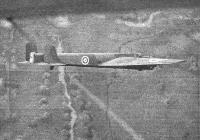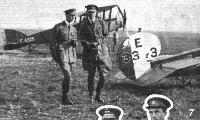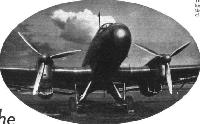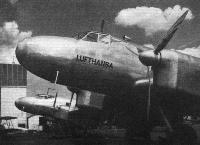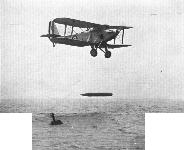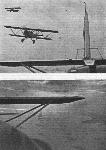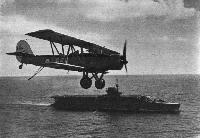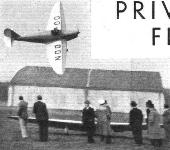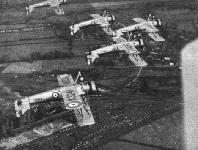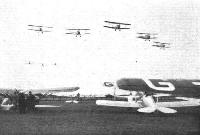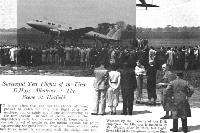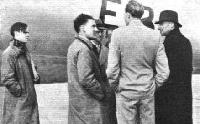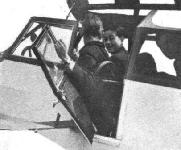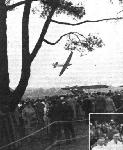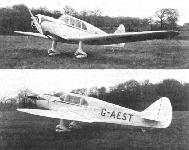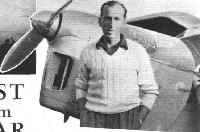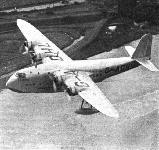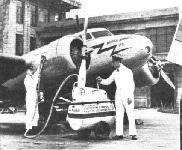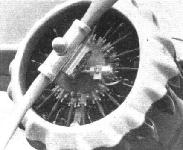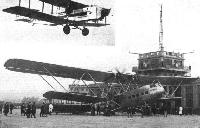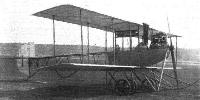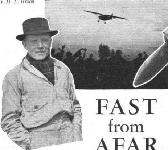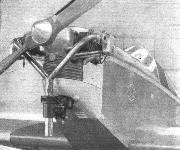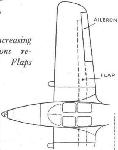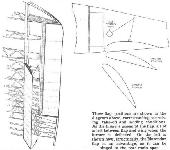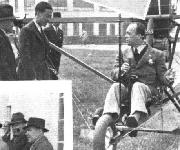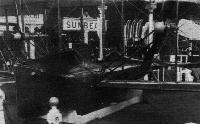Фотографии
-
HIGH SPEED, LONG RANGE, HEAVY LOAD: The Armstrong Whitworth Whitley, ordered in large quantities for the R.A.F. The engines of this machine, which Flt. Lt. Turner-Hughes recently flew for Flight's photographer, are at present 795 h.p. Siddeley Tiger IXs, and D.H. v.p. airscrews are fitted.
Самолёты на фотографии: Armstrong Whitworth Whitley / A.W.38 - Великобритания - 1936
-
MAN-MADE MIMICRY: The A.W. Whitley, with the new camouflage scheme, melts into the landscape.
Самолёты на фотографии: Armstrong Whitworth Whitley / A.W.38 - Великобритания - 1936
-
ON HER BEAM ENDS: Flt. Lt. Turner-Hughes demonstrates the manoeuvrability of the Armstrong-Whitworth Whitley heavy bomber. It. can be seen that the camera was aimed almost vertically at the ground.
Самолёты на фотографии: Armstrong Whitworth Whitley / A.W.38 - Великобритания - 1936
-
Регистрационный номер: K7033 The Bristol Blenheim bomber indicates the progress made.
Самолёты на фотографии: Bristol Blenheim - Великобритания - 1936
-
Регистрационный номер: K4240 VISIBLE PITCH: Careful study of this Flight photograph of a Handley Page Hampden will reveal spirals of vapour trailing from the airscrew tips. The photograph is untouched.
Самолёты на фотографии: Handley Page Hampden / H.P.52 - Великобритания - 1936
-
Регистрационный номер: K5083 Самолёты на фотографии: Hawker Hurricane - Великобритания - 1935
-
Four German types in regular service fitted with Junkers Jumo compression-ignition engines.
Самолёты на фотографии: Dornier Do.18 - Германия - 1935Junkers G 38 - Германия - 1929Junkers Ju.52/3m - Германия - 1931Junkers Ju.86 - Германия - 1934
-
Регистрационный номер: K4303 The Fairey Battle medium bomber is a two-seater with the Rolls-Royce Merlin engine, and has been ordered in large numbers for the R.A.F.
Самолёты на фотографии: Fairey Battle - Великобритания - 1936
-
Not the D.H.1: Capt. G. de Havilland was responsible for the design of the B.E.2 shown here, but this was not his first machine.
Самолёты на фотографии: RAF B.E.2 - Великобритания - 1912
-
FIRST ATLANTIC FLIGHT: THE VICKERS "VIMY" WAS USED BY ALCOCK AND BROWN IN FLIGHT ACROSS ATLANTIC IN 1919.
The Vickers Vimy with Rolls-Royce Eagle engines was the first aeroplane type to cross the Atlantic, to fly from England to S. Africa, and from England to Australia. All these flights were made in 1919.Самолёты на фотографии: Vickers Vimy / FB.27 - Великобритания - 1917
-
Регистрационный номер: K6127 The latest Westland is the Lysander army co-operation monoplane.
Самолёты на фотографии: Westland Lysander - Великобритания - 1936
-
Mr. C. S. Rushbrooke's Fokker D. VIII.
Самолёты на фотографии: Fokker E.V/D.VIII - Германия - 1918
-
Регистрационный номер: E3373, F4325 His Majesty as a Squadron Leader, seen near two famous war-time types, the Bristol Fighter and the Avro 504.
Самолёты на фотографии: Avro Avro 504 - Великобритания - 1913Bristol F.2A/F.2B Fighter - Великобритания - 1916
-
Регистрационный номер: G-EASI Vimy Commercial G-EASI in Instone's dark blue livery.
An early British passenger-carrier was the Vimy Commercial. In addition to those used in this country a large number was sold abroad, including 40 to China.Самолёты на фотографии: Vickers Vimy Commercial - Великобритания - 1919
-
Armstrong Whitworth aircraft: The picture shows two A.W. "Quads," which were single-seater fighters. The wing arrangement was intended to give a good view for the pilot. The wings were heavily staggered.
Самолёты на фотографии: Armstrong Whitworth F.K.10 - Великобритания - 1916
-
Bristol beginnings are shown here, which shows Graham Gilmour flying a Bristol "Box-kite" from the Haslar sea wall in 1911.
Самолёты на фотографии: Bristol Boxkite - Великобритания - 1910
-
Регистрационный номер: G-EBKT Makers of light plane history. The first D.H. 60 Moth, G-EBKT, with 60 h.p. Cirrus engine. This machine was De Havilland's interpretation of what a light aeroplane should be like. The machine was produced in 1925.
Самолёты на фотографии: De Havilland Moth / D.H.60 - Великобритания - 1925
-
Not a case of cause and effect, but just a successful landing to get a close-up view of somebody else's unsuccessful one. The incident happened at Campo dos Afonsos, near Rio.
Самолёты на фотографии: WACO 10 / O Series - США - 1927
-
In the photograph of the Boulton & Paul "Bourges" (two A.B.C. Dragonflies) one may without stretching one's imagination too greatly see the forerunner of the modern "Sidestrand." Its first claim to publicity was the stunt flying at Hendon in the hands of Frank Courtney.
Самолёты на фотографии: Boulton Paul Bourges / P.7 - Великобритания - 1918
-
The twin-engined Boulton and Paul bombers have been almost unrivalled in their class on the score of manoeuvrability. This photograph was secured from a spinning Bourges soon after the war.
Самолёты на фотографии: Boulton Paul Bourges / P.7 - Великобритания - 1918
-
This view of a Junkers Ju.86 shows the clean installation of its Jumo 205 Diesels.
Самолёты на фотографии: Junkers Ju.86 - Германия - 1934
-
More commercial Junkers with their economical heavy-oil Jumos.
Самолёты на фотографии: Junkers Ju.86 - Германия - 1934
-
Регистрационный номер: N231 BLACKBURN "RIPON": Torpedo Carrier, with Napier "Lion" Engine.
Самолёты на фотографии: Blackburn Ripon / T.5 - Великобритания - 1926
-
Formation aerobatics by a trio of the tractable Gloster Gauntlets now in service.
Самолёты на фотографии: Gloster Gauntlet - Великобритания - 1929
-
Регистрационный номер: K5309 The air raid alarm is sounding as pilots run to their Gloster Gauntlets, already being started by the ground crew.
Самолёты на фотографии: Gloster Gauntlet - Великобритания - 1929
-
A WHIFF OF CORDITE: An Audax pilot at front-gun practice on the range at Hell's Mouth, an inlet on the Carnarvonshire coast. The drogue target is towed on a 1,000-ft. wire.
Самолёты на фотографии: Hawker Audax - Великобритания - 1931
-
A Hawker Audax at the Northolt Empire Air Day rehearsal picks up a message strung between rifles.
Самолёты на фотографии: Hawker Audax - Великобритания - 1931
-
N.C.O's from the Dominions get acquainted with features of the Dagger-engined Hawker Hector.
Самолёты на фотографии: Hawker Hector - Великобритания - 1936
-
Westland Wapiti general-purpose biplanes.
Самолёты на фотографии: Westland Wapiti - Великобритания - 1927
-
GOING HOLLYWOOD: Northrop attack machines of the U.S. Army Air Corps (Pratt and Whitney Twin Wasp Junior engine with gilled cowling) over Californian orange groves. These machines are intended primarily for ground strafing and apart from one free and four fixed Brownings are equipped for the dispensation of chemicals.
Самолёты на фотографии: Northrop A-17 / 8A Nomad - США - 1934
-
(Top) Two Blackburn Sharks of the T.S.R. squadrons. Coming up astern is an impressive formation of fleet fighters - Hawker Ospreys and Nimrods. (Lower picture) "Long lines of British and foreign warships appeared out of the haze." The aircraft carriers are distinguishable.
Самолёты на фотографии: Blackburn Shark / B-6 - Великобритания - 1933
-
Регистрационный номер: K8454 FOR ROYAL REVIEW: H.M.S. Courageous, which, together with Glorious and Furious, will be among the 277 vessels assembled at Spithead for the Royal Review to-day, Thursday. The aircraft is a Blackburn Shark T.S.R. with Siddeley Tiger engine.
Самолёты на фотографии: Blackburn Shark / B-6 - Великобритания - 1933
-
Регистрационный номер: K5257 The Saro London has two 690 h.p. Pegasus IIIs and is now going into service.
Самолёты на фотографии: Saunders-Roe London / A.27 - Великобритания - 1934
-
The latest Supermarine flying boat, the Stranraer, is shown here. Note the simple bracing.
Самолёты на фотографии: Supermarine Stranraer - Великобритания - 1934
-
Регистрационный номер: K8878 Heterogeneity at Heathrow: Some of the aircraft on view; in the foreground is the Fairey Swordfish.
Самолёты на фотографии: Fairey Swordfish - Великобритания - 1934
-
Регистрационный номер: K5935, K5951 GRACE, MIGHT AND VICTORIAN DIGNITY: A fine Royal Review impression of Fairey Swordfish of the Fleet Air Arm passing the austere bulk of H.M.S. Nelson and the contrasting lines of the Royal Yacht, Victoria and Albert.
Самолёты на фотографии: Fairey Swordfish - Великобритания - 1934
-
Регистрационный номер: K5099 [2] The Fairey P.4/34 K5099 in which Clouston carried out flights into barrage balloon cables for the RAE.
Самолёты на фотографии: Fairey Fulmar / P.4/34 - Великобритания - 1937
-
Самолёты на фотографии: Fairey Fulmar / P.4/34 - Великобритания - 1937
-
Регистрационный номер: K5099 [2] Самолёты на фотографии: Fairey Fulmar / P.4/34 - Великобритания - 1937
-
One recent Merlin installation: the Fairey to the P.4/34 specification. Radiator have a flap to suit cooling to varying flight conditions.
Самолёты на фотографии: Fairey Fulmar / P.4/34 - Великобритания - 1937
-
Регистрационный номер: K6947 Самолёты на фотографии: Handley Page Harrow / H.P.54 - Великобритания - 1936
-
CHIAROSCURISTS WITH COLOUR: “Shadow shading” a Harrow before delivery to a squadron, following an Air Ministry decision in early 1937 to camouflage all medium and heavy bombers.
Самолёты на фотографии: Handley Page Harrow / H.P.54 - Великобритания - 1936
-
Left, centre section in its jig. On the right, the three main portions of a wing being assembled.
Самолёты на фотографии: Handley Page Harrow / H.P.54 - Великобритания - 1936
-
The bomb cage (right) is built as a complete unit in a swivelling jig. On the left, outer wing portion units. Note that the skin covering already has its proper camber.
Самолёты на фотографии: Handley Page Harrow / H.P.54 - Великобритания - 1936
-
The fuselage, although of girder construction, is also built in several units. The upper picture shows two, with their front gun turrets carried on metal-covered structures. On the lower picture is the mounting and cowling of one of the Bristol Pegasus engines on the wing leading edge.
Самолёты на фотографии: Handley Page Harrow / H.P.54 - Великобритания - 1936
-
The completed Harrow. The engines are Bristol Pegasus. Note the pronounced taper of the wings.
Самолёты на фотографии: Handley Page Harrow / H.P.54 - Великобритания - 1936
-
Details of the construction of the wing centre section. The lower diagram shows the constructional ''scheme.''
Самолёты на фотографии: Handley Page Harrow / H.P.54 - Великобритания - 1936
-
Details of outer wing portion, showing how sheet-metal nose covering is built as two complete units, afterwards attached to single girder spar. Note the ingenious leading edge joint.
Самолёты на фотографии: Handley Page Harrow / H.P.54 - Великобритания - 1936
-
The ingenious tail construction. Top and bottom coverings are first attached to the tailplane ribs; then the "box" is completed by riveting-on the front and rear channels, and finally the leading edge unit is attached.
Самолёты на фотографии: Handley Page Harrow / H.P.54 - Великобритания - 1936
-
One and two: The latest single-seater Tipsy (nearest camera) alongside the new two-seater.
Самолёты на фотографии: Tipsy B / BC - Бельгия - 1937Tipsy S - Бельгия - 1935
-
Expanded for two, the Tipsy has lost none of its good looks.
Самолёты на фотографии: Tipsy B / BC - Бельгия - 1937
-
Регистрационный номер: OO-DON The two-seater Tipsy in action
Самолёты на фотографии: Tipsy B / BC - Бельгия - 1937
-
Регистрационный номер: K3238, K3239, K3240, K3241, K3242 Thanks very largely to the Avro concern the R.A.F. has always had first-class trainers. Tutors are seen here rehearsing inverted flying for an R.A.F. display.
Самолёты на фотографии: Avro Tutor/Sea Tutor/Prefect / Type 621/646/626 - Великобритания - 1929
-
Регистрационный номер: K4879 The Bristol 138 reached 50,000 ft. in 1936.
Самолёты на фотографии: Bristol Type 138A - Великобритания - 1936
-
BETWEEN CLOUD AND CROWD: Tiger Moths from the Reid and Sigrist School at Desford manoeuvre at the Leicester Coronation Air Display.
Самолёты на фотографии: De Havilland Tiger Moth / D.H.82 - Великобритания - 1931
-
Регистрационный номер: G-AEJM Самолёты на фотографии: De Havilland Express Air Liner / D.H.86 - Великобритания - 1934
-
Flying to Brussels with Her Majesty the Queen (then the Duchess of York) in the imperial Airways' liner Draco in 1935.
Самолёты на фотографии: De Havilland Express Air Liner / D.H.86 - Великобритания - 1934
-
Mr. Lindsay Everard, M.P. (facing camera), snapped with friends during the Austrian Tour. He participated in his D.H. Dragonfly, flown by Flt. Lt. A. Hole.
Самолёты на фотографии: De Havilland Dragonfly / D.H.90 - Великобритания - 1935
-
The D.R Albatross is Capt. G. de Havilland's latest design.
Самолёты на фотографии: De Havilland Albatross / D.H.91 - Великобритания - 1937
-
The prototype ready for its first flight on May 20, 1937.
Watched by the majority of the D.H. employees, the Albatross is taxied in by Mr. Waight after its third test flight. Some idea of its exceptionally clean lines may be gathered from the flying picture above.Самолёты на фотографии: De Havilland Albatross / D.H.91 - Великобритания - 1937
-
7.15 a.m.: Discussions after the very first flight. In the main group, from left to right, are Mr. R. G. Waight (pilot), Mr. A. E. Hagg (designer), Mr. F. E. N. St. Barbe (business manager), Major F. B. Halford (engines) - the last two almost out of sight behind Mr. G. de Havilland, Junr. - and Capt. Geoffrey de Havilland. Standing modestly to the left is Mr. G. D. Tucker, who assisted Mr. Waight during the preliminary trials.
Самолёты на фотографии: De Havilland Albatross / D.H.91 - Великобритания - 1937
-
MORE HANWORTH HOSPITALITY: General Aircraft Ltd., last week entertained 160 Canadian public schoolboys who are visiting Britain under the auspices of the National Council of Education of Canada. Following the fraternal Hanworth custom the party was also taken to call on Autogiro's, Kronfeld's, B.A., London Air Park Flying Club and Flying Training Ltd. Joy-rides provided the ultimate rapture.
Самолёты на фотографии: General Aircraft Monospar ST-25 Universal - Великобритания - 1935
-
"DIVINE WIND'S" crew see something of British aviation: Messrs. Iinuma and Tsukagoshi, famed for their 100-hour flight from Tokio, recently enjoyed the hospitality of that section of the Industry which centres on Hanworth. They are seen off for a trip with Mr. R. Somerset in a Monospar. They were also introduced - by Mr. R. A. C. Brie - to rotating wings.
Самолёты на фотографии: General Aircraft Monospar ST-25 Universal - Великобритания - 1935
-
Регистрационный номер: G-ADMV From a standing start : F/O. Clouston takes off the Hafner Gyroplane. He left the spot where the patch of grass is of lighter colour.
Самолёты на фотографии: Hafner AR.III Gyroplane - Великобритания - 1935
-
BUSINESS BACKING: At the official opening party of the Midland Bank Flying Club. A general view of the proceedings - with one of the Club's two B.A. Swallows in the air, and, on the ground, one of the three Demons of No. 600 (F) Sqd. A.A.F. which put up a display during the afternoon.
Самолёты на фотографии: British Klemm L.25 Swallow - Великобритания - 1933Hawker Demon - Великобритания - 1932
-
Регистрационный номер: G-AEST [2] Самолёты на фотографии: Mosscraft MA-1 / MA-2 - Великобритания - 1937
-
Регистрационный номер: G-AEST [2] Though quite conventional in appearance, the Moss monoplane certainly has very clean lines, and the tandem seating arrangement has a great deal to recommend it.
Самолёты на фотографии: Mosscraft MA-1 / MA-2 - Великобритания - 1937
-
Mr. H. L. Brook came from the Cape in 4 days by Percival Gull
Самолёты на фотографии: Percival Gull - Великобритания - 1932
-
Регистрационный номер: G-ADHL Самолёты на фотографии: Short Empire / S.23 - Великобритания - 1936
-
How the two doors of the Taifun open to leave the entire cabin clear for entry and egress.
Самолёты на фотографии: Messerschmitt Bf.108 Taifun - Германия - 1934
-
The lines of the Me.108 are well shown in this Flight photograph, taken at Reading - with P. and P. employees "seeing how."
Самолёты на фотографии: Messerschmitt Bf.108 Taifun - Германия - 1934
-
PAUSE FOR REPAIRS: A reader's snapshot of Mrs. Bonney at Alor Star, Malaya, during her recent Brisbane-Cape flight. She was awaiting the repair of a burst tyre on her elderly Klemm monoplane.
Самолёты на фотографии: Klemm Kl.32 / Kl.36 - Германия - 1932
-
Регистрационный номер: YL-AAX POWER FROM BROUGH. The V.E.F. J.-11, a light Latvian private-owner type built round one of the new Cirrus Minor engines. The speed figures quoted are 124 m.p.h. cruising and 149 m.p.h. maximum, which, for 90 h.p. and two up is good going in any language. The mounting of the tail plane is one outlandish feature to note. It appears that the occupant of the front seat has quite an extraordinarily good prospect.
CIRRUS-MINOR-ENGINED, this Latvian V.E.F. J-11 monoplane recently made a circuit of its native country in 5 hrs. 20 mins. for the 655 miles, including several demonstration stops; the average flying speed was 125 m.p.h. The machine is shortly coming to England, and those interested in demonstrations should write to Mr. Janis Vitols, 24, Queensborough Terrace, London, W.2.Самолёты на фотографии: Irbitis, VEF I-11 / I-12 / I-17 - Латвия - 1936
-
Регистрационный номер: PH-AMG On all threes: The pusher on the ground, showing the 40 h.p. Praga flat-twin engine.
Самолёты на фотографии: De Schelde Scheldemusch - Нидерланды - 1935
-
Mr. T. E. Slot, the designer, in the cockpit of the Scheldemusch. On the left is Mr. R. G. Doig, managing director of Aircraft Constructions, Ltd., who are to build the machine in this country. On the right is his business partner, Miss I. Robins.
Самолёты на фотографии: De Schelde Scheldemusch - Нидерланды - 1935
-
Mr. Van Hattum's flying scale model of the Koolhoven Junior.
Самолёты на фотографии: Koolhoven FK-53 - Нидерланды - 1936
-
Регистрационный номер: NC17633 ATLANTIC CLIPPER: Powered with four unnamed engines, undoubtedly the new 1,500 h.p. two-row Wright Cyclones, this Boeing flying boat, intended for Pan-American's transatlantic trials, should be flying this autumn. Seventy-two passengers will be accommodated over shorter distances.
Самолёты на фотографии: Boeing Boeing 314 Clipper - США - 1938
-
BREAKING NEW GROUND. The Douglas D.C.4 is to have ''tricycle" landing gear arranged as shown above. An undercarriage of this type is already under test by the U.S. Army on a Douglas amphibian. The tail unit, aerodynamically, seems a retrograde step.
Самолёты на фотографии: Douglas DC-4E - США - 1938
-
TWO-WAY SPIRIT: Merrill's Electra being refuelled on Southport Sands in readiness for its return Atlantic flight.
Самолёты на фотографии: Lockheed Electra 10 - США - 1934
-
CLEAN AND SMART: A British Airways' Lockheed Electra being filled up with engine oil from one of the Vacuum Company's new portable 50-gallon dispensing units. A rotary pump delivers oil, via a Victory meter calibrated in pints, at 2-3 galls./min. There are several ingenious features.
Самолёты на фотографии: Lockheed Electra 10 - США - 1934
-
Регистрационный номер: G-AEVX, G-AEVY Самолёты на фотографии: Stinson Reliant - США - 1933
-
The latest Lycoming-Smith electrically controlled airscrew is now a standard feature of all Reliants; its method of control is both interesting and Ingenious. This Flight photograph also shows the new type of engine cowling.
Самолёты на фотографии: Stinson Reliant - США - 1933
-
Some idea of the car-like appearance of the interior of the Reliant can be gathered from this "peep" through the door of the specially equipped Wright-engined model purchased by Mr. Bryans.
Самолёты на фотографии: Stinson Reliant - США - 1933
-
Регистрационный номер: G-AAXF The scene at Croydon when "the first 12.30 for Cape Town" left in 1932.
Самолёты на фотографии: Handley Page H.P.42 / H.P.45 - Великобритания - 1930
-
The Piaggio two-row radial of the Caproni 161 drives this enormous four-bladed airscrew.
Самолёты на фотографии: Caproni Ca.161 - Италия - 1936
-
Регистрационный номер: K1991 The Fairey monoplane flew non-stop from Cranwell to Walvis Bay in 1933.
Самолёты на фотографии: Fairey Long-Range Monoplane - Великобритания - 1928
-
A Curtiss electrically controlled fully feathering airscrew on a geared Wright Cyclone in a Navy Consolidated Patrol flying boat. These airscrews were used on the record mass formation flight from San Diego to Hawaii.
Самолёты на фотографии: Consolidated P2Y - США - 1929
-
The beginning of real flying may be said to have started with this Avro biplane of 1911. The engine was a 35 h.p. Green. Note the open aft portion of the fuselage.
Самолёты на фотографии: Avro Type D - Великобритания - 1911
-
Mr. H. F. Broadbent came from Australia in 6 1/2 Days by D.H. Leopard Moth
Самолёты на фотографии: De Havilland Leopard Moth / D.H.85 - Великобритания - 1933
-
An early monoplane (a 1912 model 50 h.p. Gnome rotary) designed by Mr. Robert Blackburn is shown in the picture. The Isaacson radial was also fitted. Note the position of the pilot's control wheel.
Самолёты на фотографии: Blackburn Mercury / Type D / Type E - Великобритания - 1911
-
BUSINESS BACKING: At the official opening party of the Midland Bank Flying Club. Here is a nice piece of line-abreast flying, in Blackburn B.2s, by the bank pupils of the R.A.F. V.R. at Hanworth.
Самолёты на фотографии: Blackburn B-2 - Великобритания - 1931
-
NAUTICAL WEIGHT-LIFTER: The Italian Cant. Z.508 flying boat with three Isotta-Fraschini engines which has lately distinguished itself by securing various height records with heavy loads.
Самолёты на фотографии: CANT Z.508 - Италия - 1936
-
Prince Cantacuzene at the controls, with the faired-in homing loop above.
Самолёты на фотографии: Caudron C.640 Typhoon - Франция - 1935
-
Самолёты на фотографии: Caudron C.640 Typhoon - Франция - 1935
-
Interiors of the Typhon cockpit are reminiscent of a watchmaker's display.
Самолёты на фотографии: Caudron C.640 Typhoon - Франция - 1935
-
Регистрационный номер: NC50E Mr. Ben Turner departs from a Curtiss Robin at Buenos Aires.
Самолёты на фотографии: Curtiss Robin / Model 50 - США - 1928
-
The new engine has been very neatly installed in the Kitten as this Flight photograph of its nose shows
Самолёты на фотографии: Dart Kitten - Великобритания - 1937
-
THE FIRST IMPERIAL AIR ROUTE: This photograph was taken at Croydon just before the start; standing beside the D.H. "Hercules" (from left to right) are Capt. F. L. Barnard (pilot), Lady Maud Hoare, Sir Samuel Hoare, Sir Eric Geddes, Sir Samuel Instone, Mr. Bullock, and Air Vice-Marshal Sir Vyell Vyvyan.
Самолёты на фотографии: De Havilland Hercules / D.H.66 - Великобритания - 1926
-
A plan view of the International Aircraft monoplane, showing location of the Marendaz flap and aileron.
Самолёты на фотографии: Marendaz Mk III - Великобритания - 1937
-
Three flap positions are shown in the diagram, corresponding to cruising, take-off and landing conditions. As the hinge is ahead of the flap, a slot is left between flap and wing when the former is deflected. On the left is shown how, structurally, the Marendaz flap is an advantage, as it can be hinged to the rear main spar.
Самолёты на фотографии: Marendaz Mk III - Великобритания - 1937
-
The first machine designed and built by the Fairey company was the F.2. It was a twin-engined bomber and is shown with wings folded.
Самолёты на фотографии: Fairey F.2 - Великобритания - 1916
-
As early as 1911 Short Brothers realised the advantages of more than one engine. The pictures show a Short biplane with two Gnome rotary engines, of which the rear drove a pusher airscrew while the front drove two tractors via chain gearing.
Самолёты на фотографии: Short Tandem Twin / S.39 Triple Twin - Великобритания - 1911
-
Makers of light plane history. The first attempt to revive interest in the "ultra light" was the Lowe-Wylde (now Kronfeld) Drone, seen here.
Самолёты на фотографии: Kronfeld Drone - Великобритания - 1932
-
"DIVINE WIND'S" crew see something of British aviation: Messrs. Iinuma and Tsukagoshi, famed for their 100-hour flight from Tokio, recently enjoyed the hospitality of that section of the Industry which centres on Hanworth. They are seen greatly intrigued by Mr. Kronfeld's exposition of his ground trainer.
Самолёты на фотографии: Kronfeld Drone - Великобритания - 1932
-
These pictures were taken during the Gordon Bennett trials of July, 1911 and show the little Nieuport single-seater, which, with an engine of only 28 h.p., managed to average about 60 m.p.h. for 50 kilometres before things started to disintegrate and the 28 h.p. was reduced to the - 10 h.p. provided by dead-stick drag. Probably its maximum was in the region of 70 m.p.h. The gentleman who is seen standing so proudly in front of the somewhat naive little flat twin engine is M. Chevalier, the pilot.
Самолёты на фотографии: Nieuport Nieuport-II - Франция - 1910
-
S. E. Saunders, of Cowes, built the hull for the first Sopwith "Bat boat." The Perry-Beadle boat shown here was built by him in 1914. The firm is now known as Saunders-Roe.
Самолёты на фотографии: Perry Beadle B.3 flying boat - Великобритания - 1914
-
Регистрационный номер: K2772 The latest Parnall General Purpose aeroplane.
Самолёты на фотографии: Parnall G.4/31 - Великобритания - 1934
-
The R.E.P. monoplane was one of the first to be built in this country by Vickers, Ltd. It had an R.E.P. semi-radial or "fan" shaped air-cooled engine. Steel construction was employed.
Самолёты на фотографии: Vickers No.1 - No.5, No.7 - Великобритания - 1911
-
Самолёты на фотографии: Westland Wagtail - Великобритания - 1918
-
Регистрационный номер: G-AEMA [3] The general lines of the C. W. Cygnet are well shown in this Flight photograph, which also shows how the screen is arranged with quite a pronounced sweep-forward. The cleanness of the cantilever undercarriage noteworthy.
Самолёты на фотографии: C.W. Aircraft Cygnet - Великобритания - 1937
-
Регистрационный номер: G-AEMA [3] Side-by-side seating, with a centrally disposed control column, is a feature of the Cygnet. This Flight photograph gives an idea of the "entry area"; there is a similar door on the starboard side. In the machine are the two directors of the company, Messrs. S. I. Waddington (nearest camera) and C. R. Chronander.
Самолёты на фотографии: C.W. Aircraft Cygnet - Великобритания - 1937
-
Регистрационный номер: G-AEMA [3] From a three-quarter front view the Cygnet has somewhat squat, though not unattractive lines. The prototype machine is fitted with a Cirrus Minor engine.
Самолёты на фотографии: C.W. Aircraft Cygnet - Великобритания - 1937
Статьи
- Flight
- Flight Advertisements


